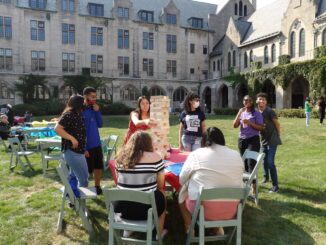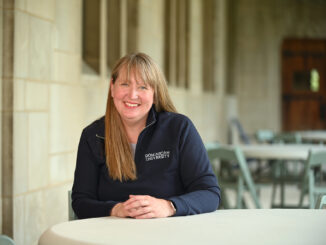
Isabelle Schindler
Staff Writer
There is a divide that has been present at Dominican for many years. Protests have taken place in 2012, 2015, and 2016 all with the intent to bring issues of inclusion, race, and ethnicity to light. The divide is still relevant today especially after talking to two Dominican faculty who each had different outlooks on how Dominican is doing as far as equity and inclusion.
Faculty and staff are working on these issues but are divided as to progress made on equity and inclusion since these protests took place
On Oct. 17, 2016 a protest took place at Dominican to show solidarity with the black students around the country. A gap had been present for a long time in colleges and universities around the U.S. and Dominican was no exception.
“The students at Dominican began their protest in the Dining Hall and marched to the Office of the President,” recalled Chief Diversity Officer Sheila Radford-Hill. “After the protest the student leaders met with Donna and presented Dominican with a list of recommendations.” Something similar happened when a few months ago UIA (Undocumented and Immigration Alliance) and OLA (Organization of Latin Americans) sent a letter to Donna Carroll with recommendations, to improve the climate for students of color and immigration status.
Lisa Petrov, Title V project director and Spanish professor, recalls the day of the 2016 protest as being, “a really nice day outside, but the feelings were gloomy.” Title V comes from the Higher Education Act and is focused on improving higher education opportunities for Hispanics.
“I felt that the students’ perspective really needed to be taken seriously because it was coming from a place of pain and hurt,” Petrov said.
Both Radford-Hill and Petrov recognized that the Dominican administration responded to the protests in a defensive manner.
“At the very least when someone is being vulnerable, speaking truth to power, they should not be met with defensiveness,” said Petrov.
Radford-Hill pointed out that, “many students were not in agreement with the protests and some of their comments were insensitive.”
A BSU (Black Students Union) member who attended the 2016 protest, Kate Brien, said she was disappointed in the response of Dominican’s administration, including those of President Donna Carroll.
“I remember many students feeling underwhelmed and disappointed at her words,” Brien said. “I left feeling disheartened and worried that the inaction would continue and to some it has.”
Although protests aided students in publicizing diversity, there is a split of opinion on whether or not protests are useful and truly effective. Petrov said she thinks they are a last resort.
“I don’t think it’s an effective method of getting anything done. I don’t think students see them as an effective means of making change, if there were protests it would be to raise awareness for the problem not necessarily to make change,” said Petrov.
Radford-Hill pointed out that protests often start and acknowledge the need for change.
“I felt that protest is a valid way to express the need for change. People who do not feel heard, often feel the need to disrupt,” said Radford-Hill.
Faculty/staff diversity:
Diversity among faculty is also a big issue. According to collegefactual.com the stats of diversity at Dominican, right now, are 48.1% Hispanic, 35.3% White, 6.6% Black or African American, and 3.4% Asian among students. Among faculty the stats are 72% White, 10% Hispanic, 7.7% Black or African American, and 3.7% Asian.
“Not only do students need to see themselves in the content of the course, they need to see themselves in the people delivering the content of the course,” said Petrov.
Radford-Hill pointed out that progress was being made.
“The faculty and staff are more aware and some are more engaged than ever. I think we are working toward an equitable and inclusive campus but I know that as we become more intentional about living together inclusively, we have to address the different needs of all our students,” said Radford-Hill.
Whatever progress Dominican makes in numbers as far as diversity, Brien thinks it’s important to keep in mind what’s best for the students and overall campus climate.
“No one wants to be the token Black faculty,” said Brien.
Overall inclusiveness on campus:
Radford-Hill and Petrov also have different assessments in whether Dominican has improved its inclusiveness.
“I don’t have a sense that there is a “we” in the staff and faculty that are truly in solidarity,” said Petrov.
Radford-Hill claimed many on campus are still working hard for inclusion.
“We are building a community of support for all, that is what we are doing well,” said Radford-Hill.
Petrov, however, did give some credit to the work being done.
“The Diversity Committee got inclusive teaching to be part of the faculty handbook, so now any new faculty that comes in has to demonstrate competence in inclusive teaching,” she said.
But the progress is proven too slow for some students.
“There is no definite end to racism and its impact on student success on Dominican University Campus,” Brien said. “However, that does not mean the administration is allowed to act so slowly.”
Some of the issues that motivated protests in 2015 and 2016 are still with Dominican. Petrov and Brien have different views about the future.
“It’s important for us to not force students to protest,” Petrov said. “We should never let things go to the point where students really feel the need to protest.”
But Brien said sometimes Dominican needs a little push from the students.
“Students are likely to protest again if there isn’t a commitment made by the university to diversify the curriculum, the faculty, the training, and the programs,” Brien said.



